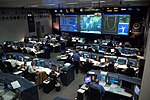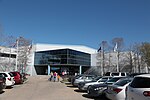Space Environment Simulation Laboratory
Buildings and structures in HoustonHistoric American Engineering Record in TexasJohnson Space CenterNational Historic Landmarks in TexasNational Register of Historic Places in Houston ... and 1 more
Use mdy dates from August 2023

The Space Environment Simulation Laboratory (SESL) is a facility in Building 32 at the Lyndon B. Johnson Space Center that can perform large-scale simulations of the vacuum and thermal environments that would be encountered in space. Built in 1965, it was initially used to test Apollo Program spacecraft and equipment in a space environment, and continues to be used by NASA for testing equipment. It was designated a National Historic Landmark in 1985.
Excerpt from the Wikipedia article Space Environment Simulation Laboratory (License: CC BY-SA 3.0, Authors, Images).Space Environment Simulation Laboratory
2nd Street, Houston
Geographical coordinates (GPS) Address Nearby Places Show on map
Geographical coordinates (GPS)
| Latitude | Longitude |
|---|---|
| N 29.560555555556 ° | E -95.088055555556 ° |
Address
2nd Street
77058 Houston
Texas, United States
Open on Google Maps









